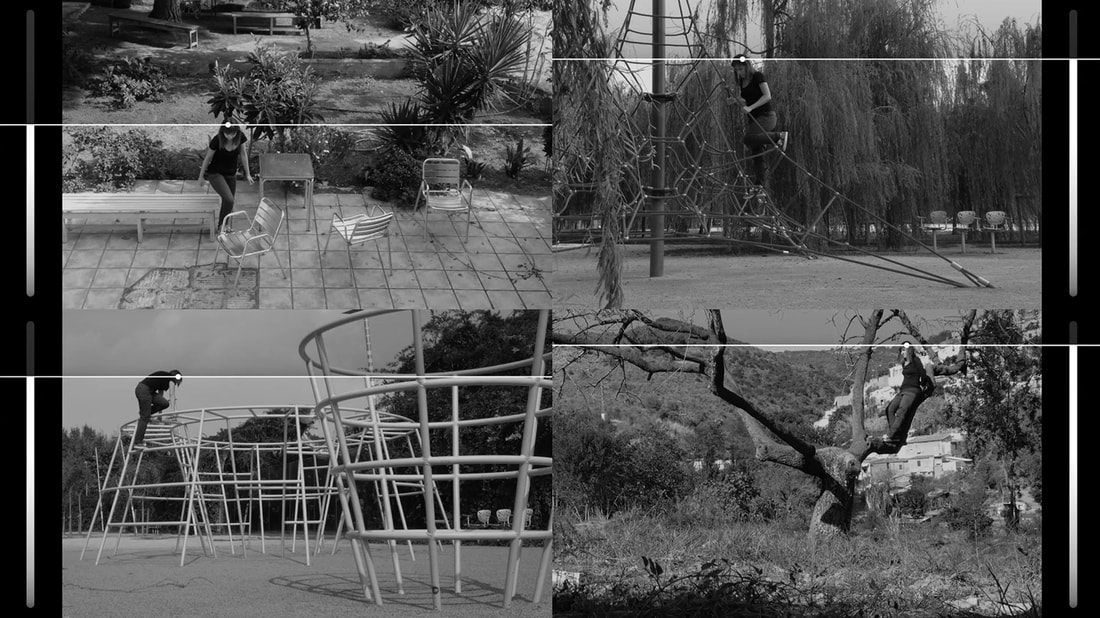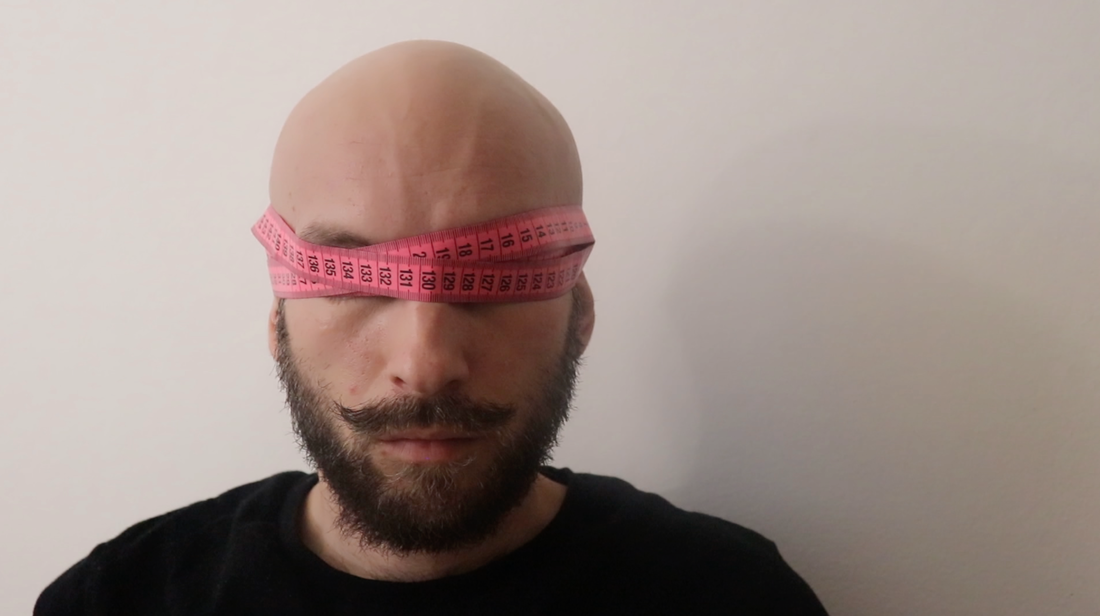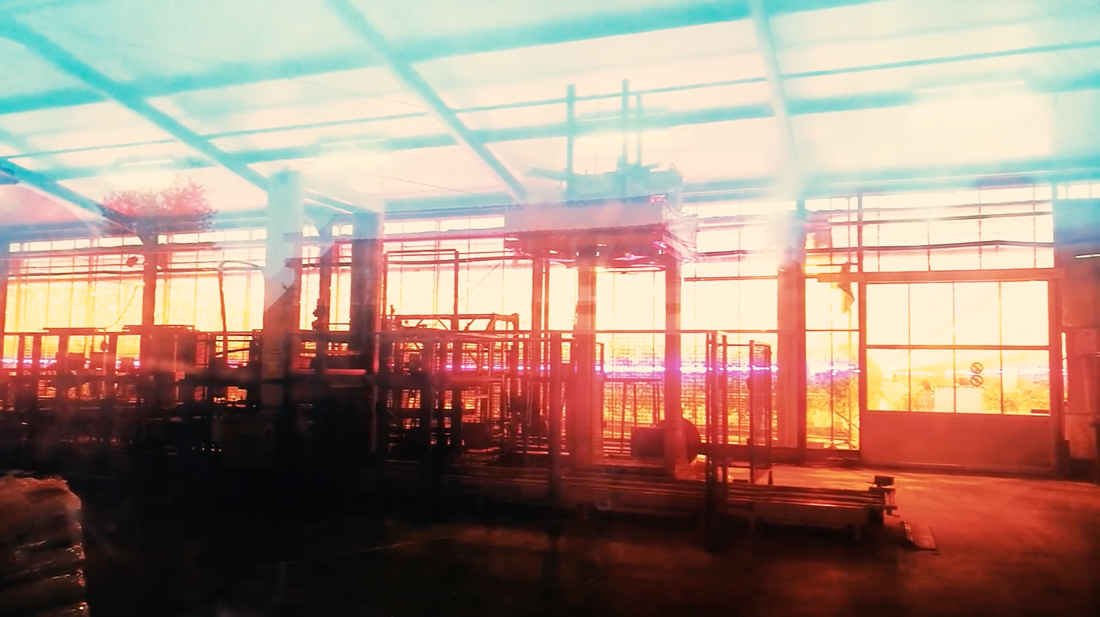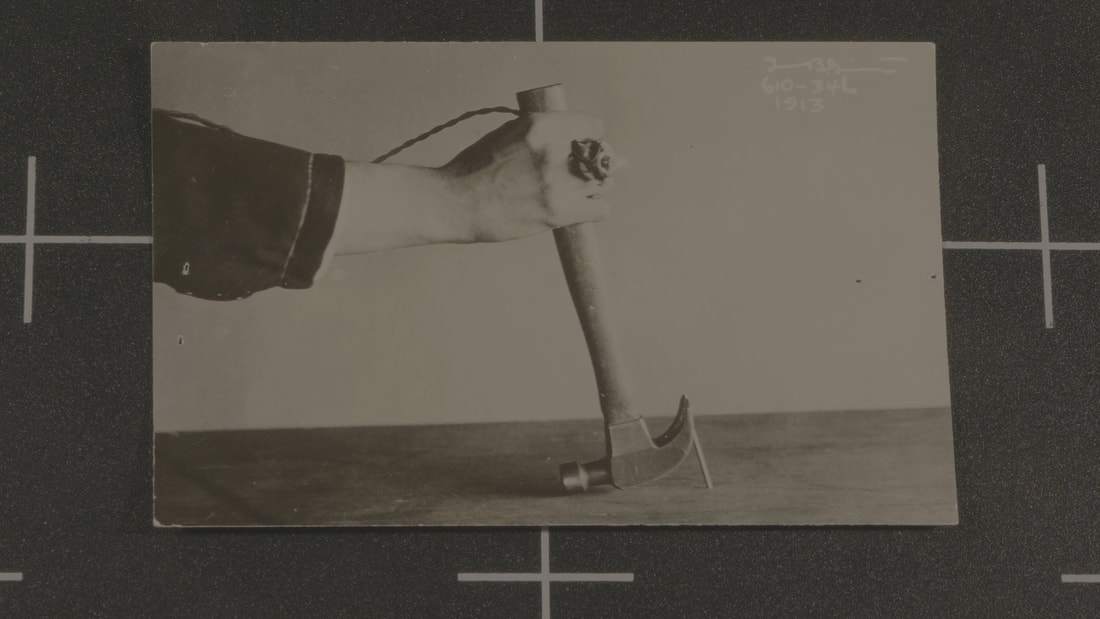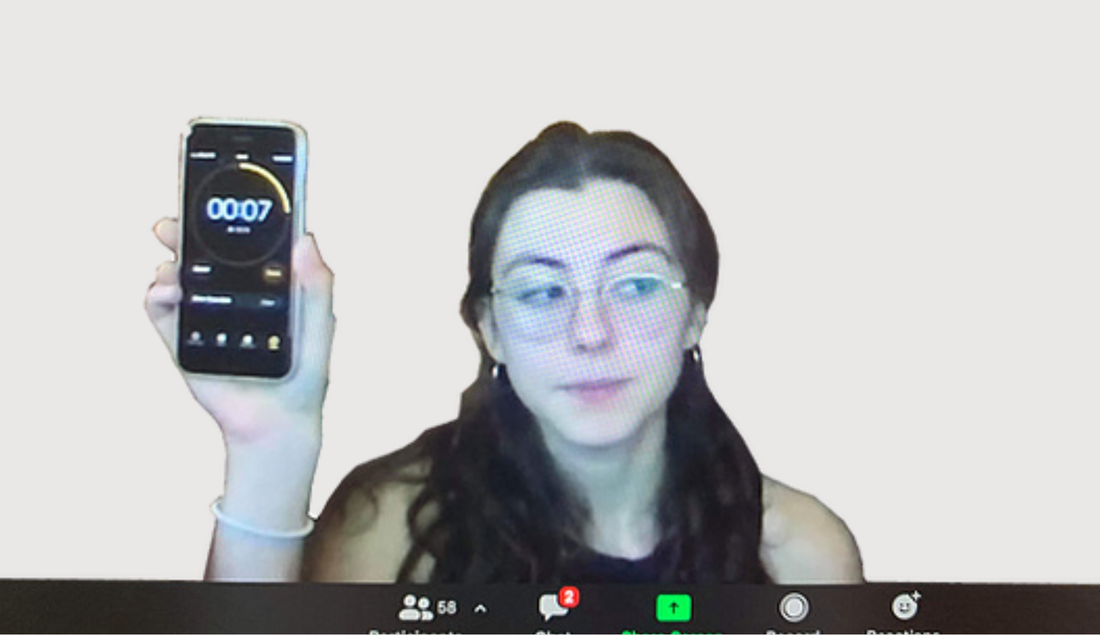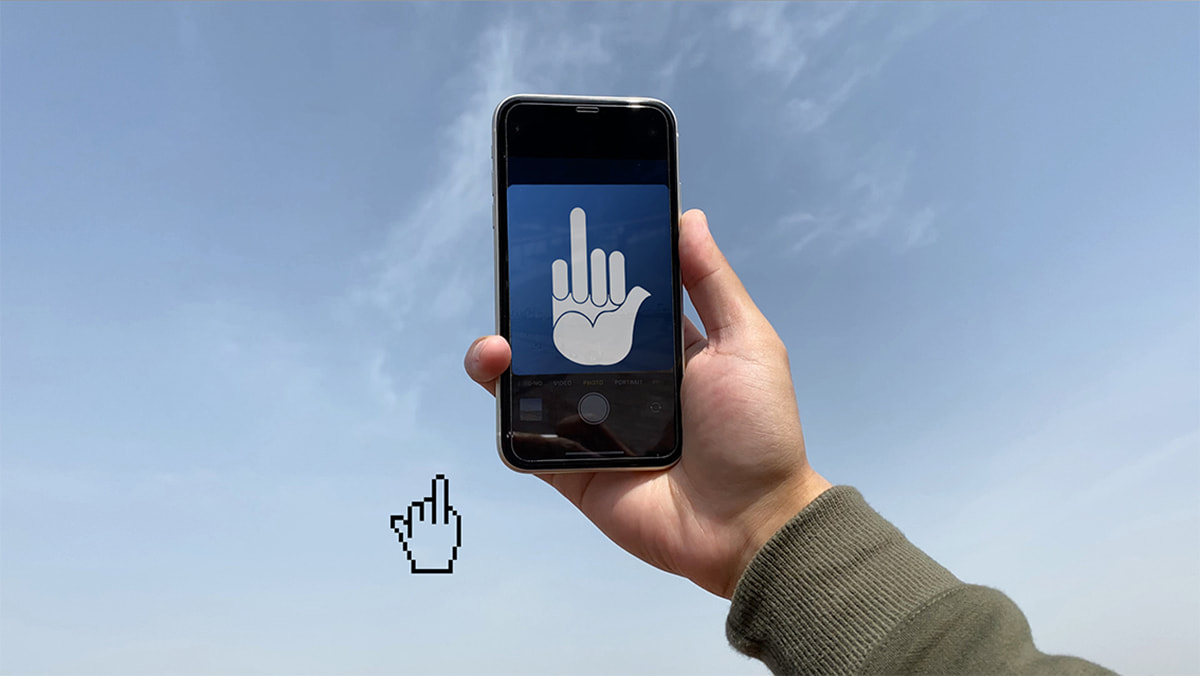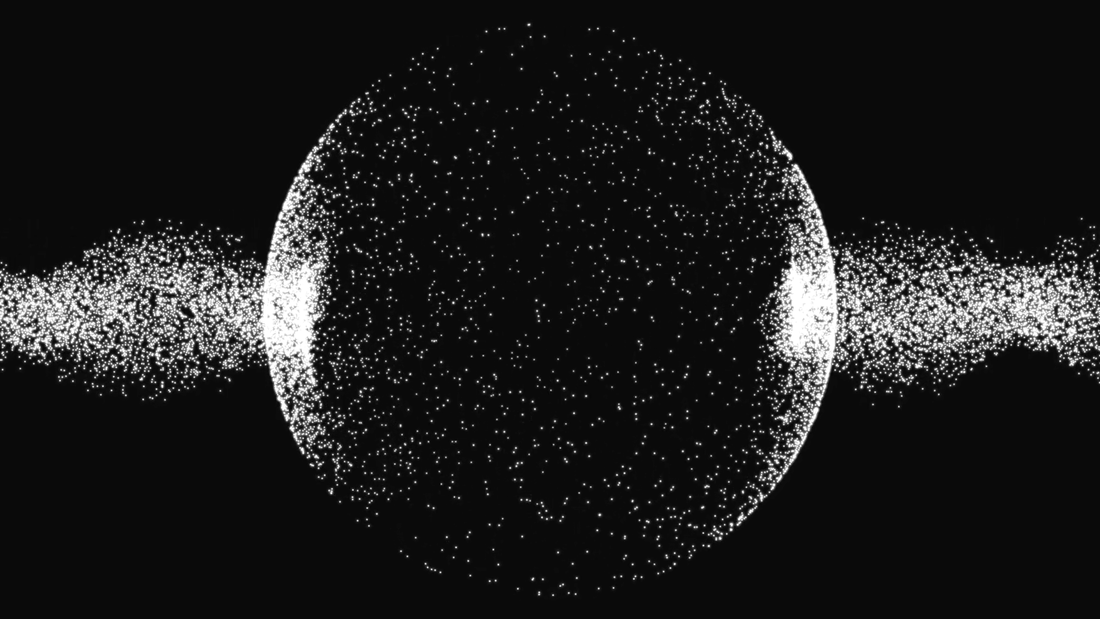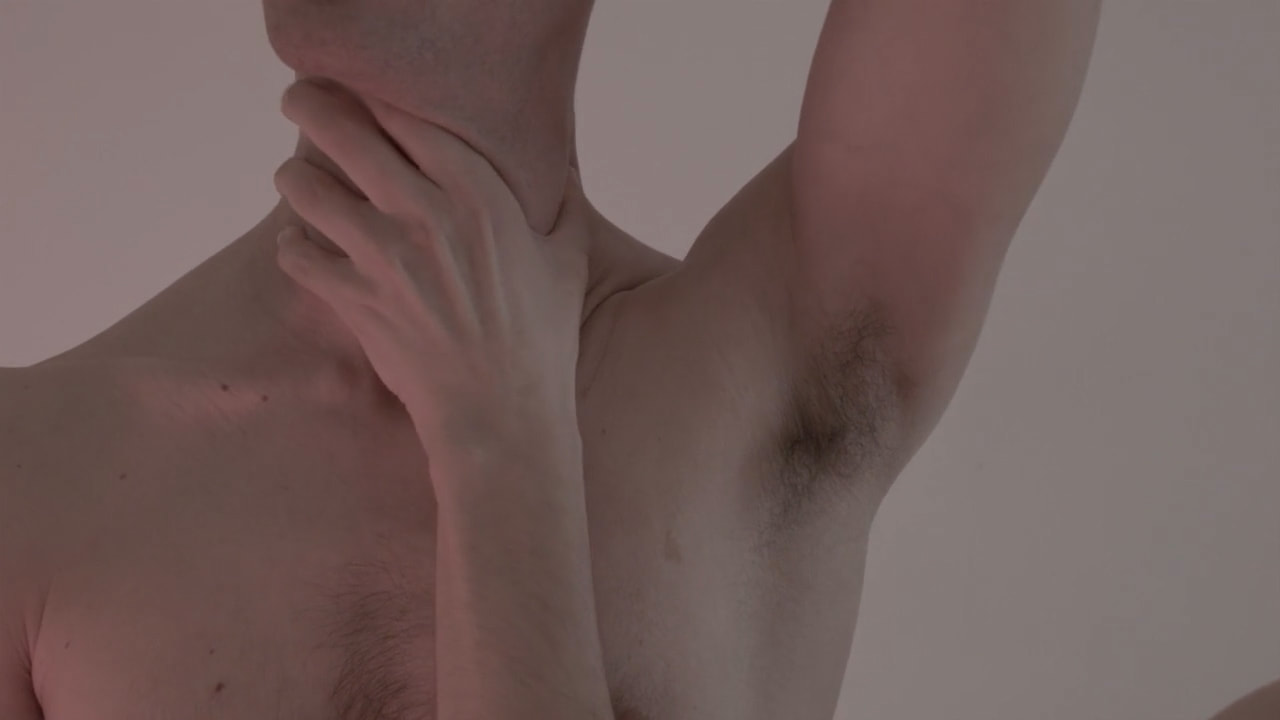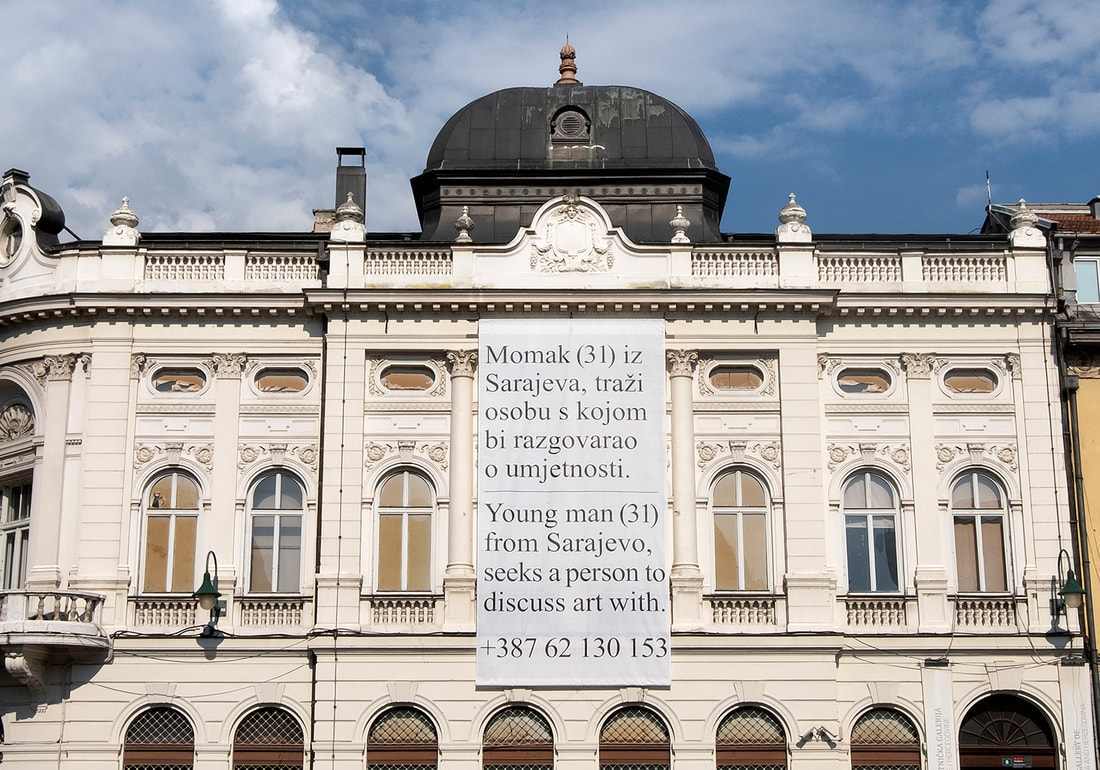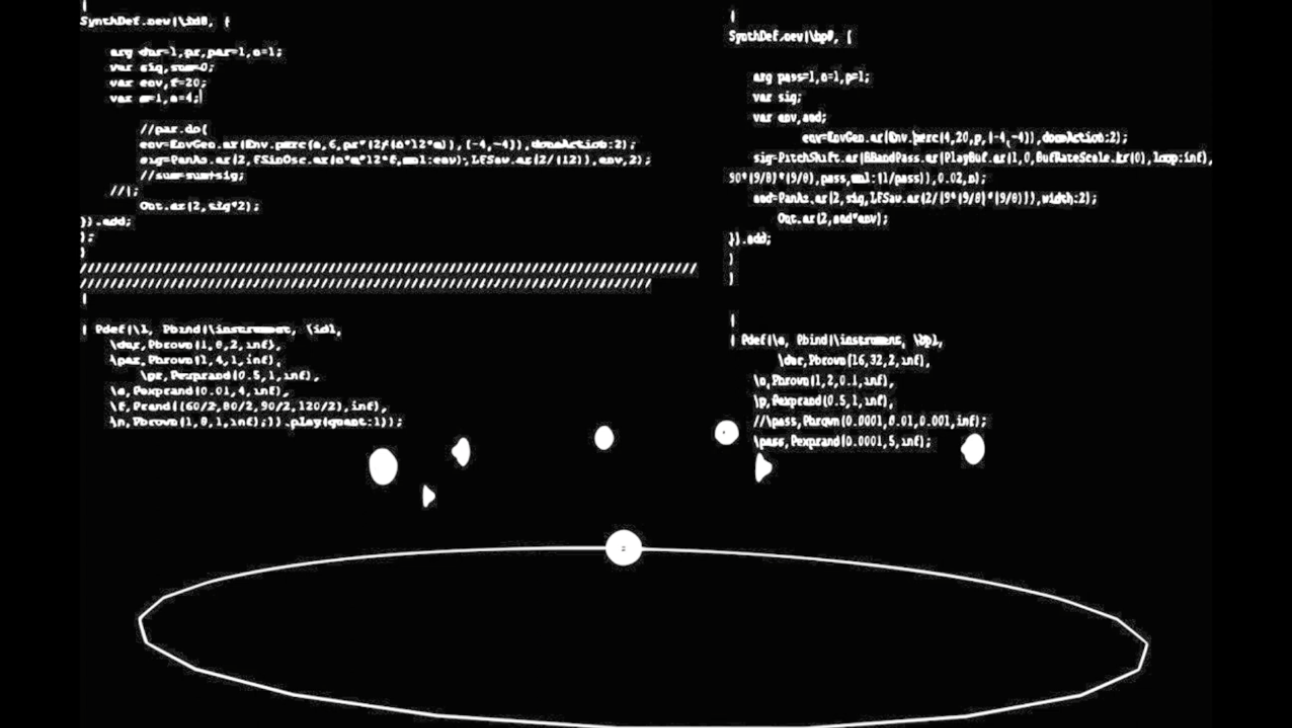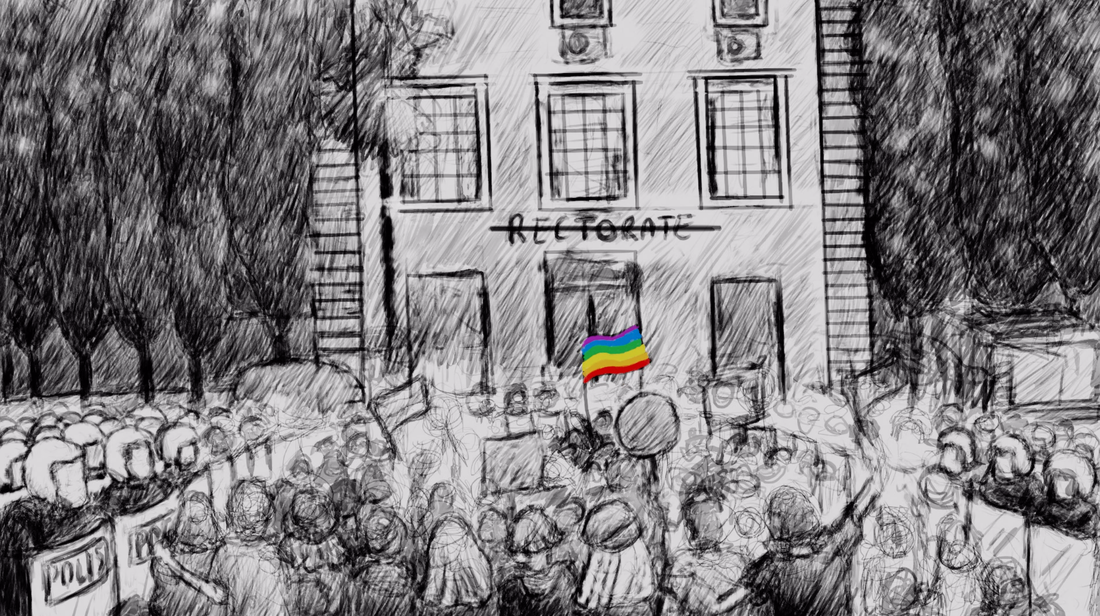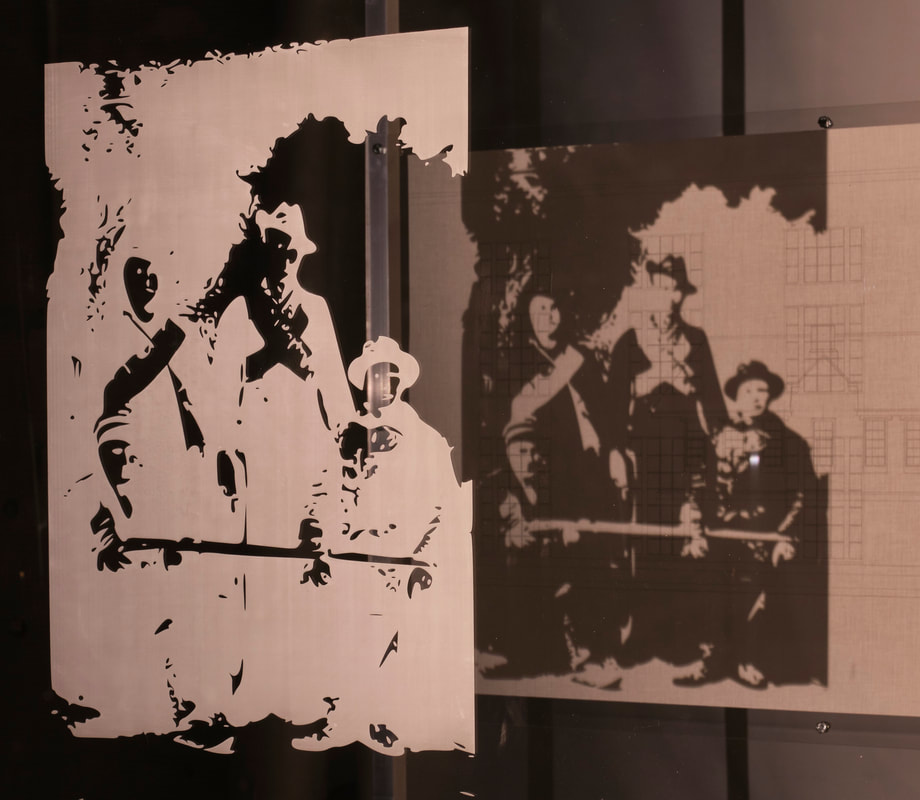Ewa Doroszenko and Jacek Doroszenko
The same horizon repeated at every moment of the walk, 2014
Video, Full HD, 2’ 56’’
Throughout history, there have been a lot of concepts of movement — from body language to various kinds of dance to floating above the ground like levitation. In fact, movement is a simple function, with the basic purpose to get from one point to another. All other concepts on movement are cultural constructs and intellectual associations. Building on this simple principle, we treat the body as the driving force of a simple starting point. A point that can be moved by the body and therefore displaced to different locations. In this case, the point is a unique conveyor – it carries sound. The video is based on the pitch phenomenon, a perceptual property that allows the ordering of sounds on a frequency-related scale. The composition is made of four frames, in which the moving figure’s head determines the pitch on the scale of each frame, from higher to lower. This aleatoric quartet reveals a specific approach, where some primary elements of a composed work’s realisation are left to the determination of its performer.
https://ewa-doroszenko.com
https://doroszenko.com
Throughout history, there have been a lot of concepts of movement — from body language to various kinds of dance to floating above the ground like levitation. In fact, movement is a simple function, with the basic purpose to get from one point to another. All other concepts on movement are cultural constructs and intellectual associations. Building on this simple principle, we treat the body as the driving force of a simple starting point. A point that can be moved by the body and therefore displaced to different locations. In this case, the point is a unique conveyor – it carries sound. The video is based on the pitch phenomenon, a perceptual property that allows the ordering of sounds on a frequency-related scale. The composition is made of four frames, in which the moving figure’s head determines the pitch on the scale of each frame, from higher to lower. This aleatoric quartet reveals a specific approach, where some primary elements of a composed work’s realisation are left to the determination of its performer.
https://ewa-doroszenko.com
https://doroszenko.com
Adam Engler
UnityCore, 2021
Video performance
The work reflects the state of trust in today’s society. I am responding to the current situation in the online and offline space, for which many, many were not prepared — fake news, hoaxes and conspiracies and their direct influence on reality outside the online space, and vice versa. What is the level of people's trust in institutions and can they trust each other? Do we live in a society with double standards? The work draws attention to the issue of trust / distrust through a performative act. A performative act captured on video using the symbolism of a tailor's tape measure blindfolding the eyes. As a blindfolded performer (blindfolded by the tailor's tape measure) in a video, I am trying to create the word TRUST from pieces of tailor's metro measure.
https://www.instagram.com/adam.engler.artwork/
The work reflects the state of trust in today’s society. I am responding to the current situation in the online and offline space, for which many, many were not prepared — fake news, hoaxes and conspiracies and their direct influence on reality outside the online space, and vice versa. What is the level of people's trust in institutions and can they trust each other? Do we live in a society with double standards? The work draws attention to the issue of trust / distrust through a performative act. A performative act captured on video using the symbolism of a tailor's tape measure blindfolding the eyes. As a blindfolded performer (blindfolded by the tailor's tape measure) in a video, I am trying to create the word TRUST from pieces of tailor's metro measure.
https://www.instagram.com/adam.engler.artwork/
Catalina Gonzalez
The Murmur, 2021
Video
The Murmur is a raw edited video, which juxtaposes two worlds in contrast — the urban protests in Chile in 2019 and the former Mapuche land on Isla Mocha. The two worlds are linked through the artificial landscape created by the inhabitants and through the possibility of connecting with primary energy through rituals. As the flame on the shore of the Pacific Ocean lights up, a ritual takes place in the southern part of the world; a ritual coming from community knowledge, disappearing and then reappearing like a murmur. The earth emits communication signals in vibrational nets to protest and dismantle the concrete.
https://www.cata-gonzalez.com
Image: Zona Crepuscular, film still
The Murmur is a raw edited video, which juxtaposes two worlds in contrast — the urban protests in Chile in 2019 and the former Mapuche land on Isla Mocha. The two worlds are linked through the artificial landscape created by the inhabitants and through the possibility of connecting with primary energy through rituals. As the flame on the shore of the Pacific Ocean lights up, a ritual takes place in the southern part of the world; a ritual coming from community knowledge, disappearing and then reappearing like a murmur. The earth emits communication signals in vibrational nets to protest and dismantle the concrete.
https://www.cata-gonzalez.com
Image: Zona Crepuscular, film still
Ryan S. Jeffery
An Unsatisfying Metaphor, 2020
Color HD video, stereo sound, 40'
This film begins with the contention that an economy is fundamentally a set of institutions constructed by humans in the face of a radically uncertain world. What then can be understood about the story of modern or “hyper” globalisation if we look to the World Trade Organisation’s private art collection in Geneva, Switzerland? The subjects and objects depicted inside this intergovernmental institution’s walls reveal a story, or stories, told by those who have sought to shape and command the heights of a world economy. Who gets to be in the picture and who is left out? And who gets to draw the picture in the first place?
https://www.ryansjeffery.com
This film begins with the contention that an economy is fundamentally a set of institutions constructed by humans in the face of a radically uncertain world. What then can be understood about the story of modern or “hyper” globalisation if we look to the World Trade Organisation’s private art collection in Geneva, Switzerland? The subjects and objects depicted inside this intergovernmental institution’s walls reveal a story, or stories, told by those who have sought to shape and command the heights of a world economy. Who gets to be in the picture and who is left out? And who gets to draw the picture in the first place?
https://www.ryansjeffery.com
Nefeli Kentoni
An Adaptation, 2021
Video
"An Adaptation" is a revision of a prior performance which was written pre-pandemic. The piece was intended for a live audience, and this is an attempt to adapt it for a digital one. What remains when the traditional stage and auditorium disappear? Do the roles of the performer and audience disappear as well? "An Adaptation" makes the labours and implicit exertions that sustain the performer-viewer relationship visible, and questions their dependency and even existence behind a screen.
www.nefelikentoni.com
"An Adaptation" is a revision of a prior performance which was written pre-pandemic. The piece was intended for a live audience, and this is an attempt to adapt it for a digital one. What remains when the traditional stage and auditorium disappear? Do the roles of the performer and audience disappear as well? "An Adaptation" makes the labours and implicit exertions that sustain the performer-viewer relationship visible, and questions their dependency and even existence behind a screen.
www.nefelikentoni.com
Tingwei/ Li
digitus digitālis, 2020
Video, 2’’
Video, 1’ 41’’
The "handless, two-fingering human being" of the future —Homo digitalis— will not be a man of action. This hand is a sacred symbolic representation — the symbolic body becomes degenerate in the result of the digitalised world. Vilém Flusser claimed that today’s human being, equipped with digital apparatuses, is already living the “immaterial life of tomorrow”. Manual atrophy characterises such an existence. Digital technology is making human hands waste away. It means liberation from the burden of matter. The term “digital” itself references the finger and counting. In the future, humankind will no longer need hands. The new man will no longer have to handle or work on anything: he will have truck not with physical things but only with immaterial information. Fingers will take the place of hands. The new man will finger instead of handling or acting. Human beings regarded nature as hierophany and nowadays people are obsessed with mobile electronic devices. This contrast gently touches on the worries about body alienation and faith transformation. Ancient peoples believed that when they died, beliefs did not also die, but just fell asleep. The eternity of the soul of modern people after death may be just as the eternal existence of data.
www.litingwei.de
Video, 1’ 41’’
The "handless, two-fingering human being" of the future —Homo digitalis— will not be a man of action. This hand is a sacred symbolic representation — the symbolic body becomes degenerate in the result of the digitalised world. Vilém Flusser claimed that today’s human being, equipped with digital apparatuses, is already living the “immaterial life of tomorrow”. Manual atrophy characterises such an existence. Digital technology is making human hands waste away. It means liberation from the burden of matter. The term “digital” itself references the finger and counting. In the future, humankind will no longer need hands. The new man will no longer have to handle or work on anything: he will have truck not with physical things but only with immaterial information. Fingers will take the place of hands. The new man will finger instead of handling or acting. Human beings regarded nature as hierophany and nowadays people are obsessed with mobile electronic devices. This contrast gently touches on the worries about body alienation and faith transformation. Ancient peoples believed that when they died, beliefs did not also die, but just fell asleep. The eternity of the soul of modern people after death may be just as the eternal existence of data.
www.litingwei.de
Menelaos Lomis
An ever changing stage, 2021
moving image and sound composition, 1' 20''
An ever changing stage shows how the message can remain true to its core
even if the “stage” changes dramatically. Initially “an ever changing stage” was a project that wanted to touch multiple subjects over the course of 15second increments. The project evolved into a piece. A piece that fluctuates between the concept of democracy, decentralisation, and a question.
An ever changing stage shows how the message can remain true to its core
even if the “stage” changes dramatically. Initially “an ever changing stage” was a project that wanted to touch multiple subjects over the course of 15second increments. The project evolved into a piece. A piece that fluctuates between the concept of democracy, decentralisation, and a question.
Angelos Papadopoulos
Body Politics_Porn Me, 2021
Video, 7' 56''
Recently, social distance is imposed, and physical contact is under supervision. “Body Politics_Porn Me” proposes an alternative voyeuristic reading on contact. Α video that demonstrates the body as it is, naked. The camera captures the relations of two bodies as they play games of dominance and submission. The body loses its solid identity and is discovered as a fluid site of communication. An on-site investigation of acts of dialogue, attention and registration of the body is taking place on screen. Visual narratives reclaim the human touch and intercourse for the corporeal practices of pleasure and desire. Foucault says that the body is “directly involved in a political field”, that power relations “have an immediate hold upon it; they invest it, mark it, train it, torture it, force it to carry out tasks, to perform ceremonies, to emit signs”. (Foucault 1995: 25)
Idea-Direction: Angelos Papadopoulos
Editing-Camera: Christiana Chiranagnostaki
Interpretation: Fotis Haronis, Thanos Ragousis
Special thanks to ECATI
https://www.angelospapadopoulos.com/
Recently, social distance is imposed, and physical contact is under supervision. “Body Politics_Porn Me” proposes an alternative voyeuristic reading on contact. Α video that demonstrates the body as it is, naked. The camera captures the relations of two bodies as they play games of dominance and submission. The body loses its solid identity and is discovered as a fluid site of communication. An on-site investigation of acts of dialogue, attention and registration of the body is taking place on screen. Visual narratives reclaim the human touch and intercourse for the corporeal practices of pleasure and desire. Foucault says that the body is “directly involved in a political field”, that power relations “have an immediate hold upon it; they invest it, mark it, train it, torture it, force it to carry out tasks, to perform ceremonies, to emit signs”. (Foucault 1995: 25)
Idea-Direction: Angelos Papadopoulos
Editing-Camera: Christiana Chiranagnostaki
Interpretation: Fotis Haronis, Thanos Ragousis
Special thanks to ECATI
https://www.angelospapadopoulos.com/
Bojan Stojčić
Seeking for a Person, 2013-ongoing
Public ad, various formats / correspondence, screenshots
The ad reads "Young man (33) from Sarajevo, BiH, seeks a person to discuss art with", with my personal phone number attached to it. Over time, I have been posting it on the ad sections of daily newspapers, as well as at exhibition spaces in France, Bosnia and Herzegovina, Hungary, and Serbia. Reduced to the form of an ad, this work does not necessarily immediately communicate its artistic intention to the public, opening it to everybody – even those people who are less likely to respond to an artistic event. The topics discussed or avoided in calls and reactions become a transcript of characteristics, longings, ideologies, wishes, fears, prejudice, traumas, as well as the language and slang permeating a community or the intimacy of its members. Set in different contexts, the ad questions the borders, confinements of conversations, thus questioning different social imaginaries. In the context of Bosnia and Herzegovina, as well as the countries surrounding it, this ad acquires one more intimate-political dimension bound by the axes of loneliness, lack of information, pain, as well as, frequently, longing for the Other.
https://bojanstojcic.com/
Photo: Seeking for a Person, National Gallery of Bosnia and Herzegovina, Sarajevo, 2020
The ad reads "Young man (33) from Sarajevo, BiH, seeks a person to discuss art with", with my personal phone number attached to it. Over time, I have been posting it on the ad sections of daily newspapers, as well as at exhibition spaces in France, Bosnia and Herzegovina, Hungary, and Serbia. Reduced to the form of an ad, this work does not necessarily immediately communicate its artistic intention to the public, opening it to everybody – even those people who are less likely to respond to an artistic event. The topics discussed or avoided in calls and reactions become a transcript of characteristics, longings, ideologies, wishes, fears, prejudice, traumas, as well as the language and slang permeating a community or the intimacy of its members. Set in different contexts, the ad questions the borders, confinements of conversations, thus questioning different social imaginaries. In the context of Bosnia and Herzegovina, as well as the countries surrounding it, this ad acquires one more intimate-political dimension bound by the axes of loneliness, lack of information, pain, as well as, frequently, longing for the Other.
https://bojanstojcic.com/
Photo: Seeking for a Person, National Gallery of Bosnia and Herzegovina, Sarajevo, 2020
Petros Tatsiopoulos
Installation, Stem, Impression, 2021
Video, 2' 30''
“Installation Stem, Impression” is a soundscape as part of an imaginary sound installation called Stem, made of 8 cones with transducers, designed to exist in the public digital sphere. Accessible by anyone through social media, this video aims to give an impression of the installation through a part of its sound algorithm and indicatory graphics of the code that generates it, as well as a configuration of cones (sculptural speakers). The soundscape nominalises abstracted sound waves mixed with naturally occurring, recorded sounds of birds, through a set of harmonics imposed on both worlds of sound, the abstract (synthesised sine waves) and the concrete (recording).
“Installation Stem, Impression” is a soundscape as part of an imaginary sound installation called Stem, made of 8 cones with transducers, designed to exist in the public digital sphere. Accessible by anyone through social media, this video aims to give an impression of the installation through a part of its sound algorithm and indicatory graphics of the code that generates it, as well as a configuration of cones (sculptural speakers). The soundscape nominalises abstracted sound waves mixed with naturally occurring, recorded sounds of birds, through a set of harmonics imposed on both worlds of sound, the abstract (synthesised sine waves) and the concrete (recording).
Emir Uysal
A chronological look into resistance in Boğaziçi University, 2021
Video – 2D animation, 2’
"A chronological look into resistance in Boğaziçi University" is a 2D animated video to commemorate the resistance history of the campus since 1976, ultimately tying the historical pattern of resistance to the current protests against the highly controversial appointment of new rectors by the Turkish government, which disrespects the tradition of the university and curtails academic freedom. The university and its constituents have historically been through quite a lot of conflict in various timepoints. These conflicts have mainly happened between the authority of the university and its students and/or academics. The conflicts are triggered by often outrageous incidents that occur within the domain of the university or that of the country of Turkey. The scale of the protests, and the intensity of the events during the protests vary throughout time. The same is true for the outcome of the protests, as to whether the protesting side could get what they wanted or not in these events. However, one thing remains common, that is the culture of resistance in Boğaziçi University across the decades, embedded in its collective memory.
"A chronological look into resistance in Boğaziçi University" is a 2D animated video to commemorate the resistance history of the campus since 1976, ultimately tying the historical pattern of resistance to the current protests against the highly controversial appointment of new rectors by the Turkish government, which disrespects the tradition of the university and curtails academic freedom. The university and its constituents have historically been through quite a lot of conflict in various timepoints. These conflicts have mainly happened between the authority of the university and its students and/or academics. The conflicts are triggered by often outrageous incidents that occur within the domain of the university or that of the country of Turkey. The scale of the protests, and the intensity of the events during the protests vary throughout time. The same is true for the outcome of the protests, as to whether the protesting side could get what they wanted or not in these events. However, one thing remains common, that is the culture of resistance in Boğaziçi University across the decades, embedded in its collective memory.
Una Walker
Shadows and reflections, 2021
Edited version of 2019 work, 2’ 55’’, Audio
Populist politicians utilise concepts and language which have deep roots, and which appeal at an emotional level to their followers. This work explores the sources of these concepts by examining the language in a range of declarations of independence from states which emerged in the wake of World War One. As the Russian, Ottoman and Austro-Hungarian empires collapsed, many regions seized the opportunity to declare independence. These small countries including Latvia, Estonia, Finland, Ukraine and Georgia (with Ireland as an outlier), had developed a sense of unique identity with the rise of nationalism during the nineteenth century. These declarations have common themes – the heroic past of their ancestors, the hopes of future generations, and fears of enemies without and within. The lofty ideals expressed were often matched by implicit or explicit exclusion of others, and by plans to control population through the establishment of militias (“for the maintenance of public order…”). This work charts a path from a form of idealism to repression and violence using a lexicon which has become common again in public debate and is intended to act as a warning.
www.unawalker.com
Populist politicians utilise concepts and language which have deep roots, and which appeal at an emotional level to their followers. This work explores the sources of these concepts by examining the language in a range of declarations of independence from states which emerged in the wake of World War One. As the Russian, Ottoman and Austro-Hungarian empires collapsed, many regions seized the opportunity to declare independence. These small countries including Latvia, Estonia, Finland, Ukraine and Georgia (with Ireland as an outlier), had developed a sense of unique identity with the rise of nationalism during the nineteenth century. These declarations have common themes – the heroic past of their ancestors, the hopes of future generations, and fears of enemies without and within. The lofty ideals expressed were often matched by implicit or explicit exclusion of others, and by plans to control population through the establishment of militias (“for the maintenance of public order…”). This work charts a path from a form of idealism to repression and violence using a lexicon which has become common again in public debate and is intended to act as a warning.
www.unawalker.com

